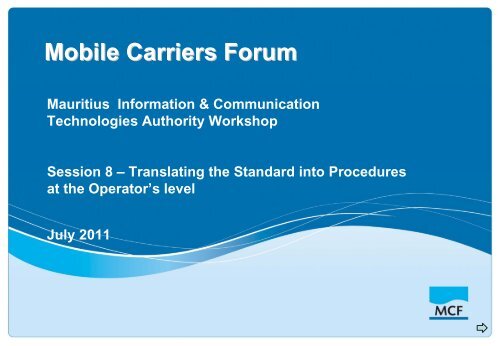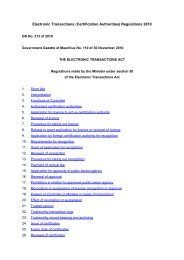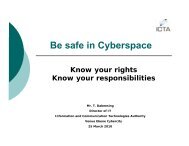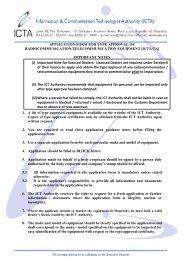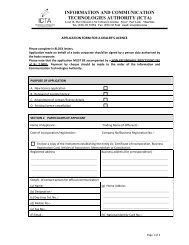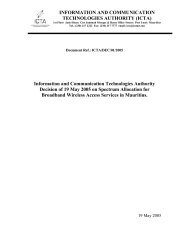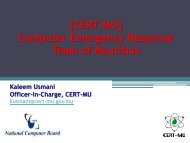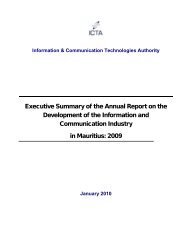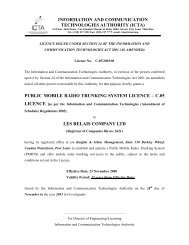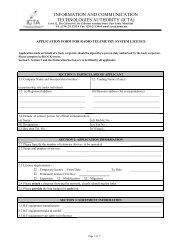Insert Title Here - ICTA
Insert Title Here - ICTA
Insert Title Here - ICTA
- No tags were found...
Create successful ePaper yourself
Turn your PDF publications into a flip-book with our unique Google optimized e-Paper software.
Mobile Carriers ForumMauritius Information & CommunicationTechnologies Authority WorkshopSession 8 – Translating the Standard into Proceduresat the Operator’s levelJuly 2011
RF Safety ComplianceCompliance with RF safety standards requires cumulative EME assessmentsEach carrier could develop their own processes and systems but would stillrequire other carrier operator data, therefore a shared approach was developed…MCF RF Safety Compliance Program:The purpose of the MCF RF Safety Compliance Program is to provide acoordinated structure, systems and processes for carrier compliance withthe mandatory EME safety standards and regulations.MCF EME Steering Committee:The purpose of the MCF EME Steering Committee is to providegovernance of the MCF RF Safety Compliance Program for the MCFNational Council.
Australian Regulatory Overview for RF Safety2001 – 2003• Established EME Management Committee• Developed standardised EME management practices through a trial know as the “EME rooftop trail”2004 – 2006• Developed the base level EME systems on the internet database called the National Site Archive• Commenced the MCF EME Regulatory Compliance Strategy (MERCS). MERCS took the processesdeveloped during the rooftop trail and turned them into an operational EME compliance system• A MERCS Coordinator was appointed to assist the MCF manage this program development2007 – 2010• Complete NSA update with all carrier sites, data, EME compliance docs – (MCF Commitment to ACMA)• Complete the EME compliance & audit processes, and documentation• Complete the EME systems development including the National Antenna Database• Program name change to RF Safety Compliance Program (RFSCP) – reflects key purpose• External review by Price Waterhouse Coopers – program achieves high level of compliance• Develop a model for sharing the program with other Radio Service Operators• Transfer the RFSCP into AMTA to facilitate sharing & broader use for wireless operators2011• Annual audit program, operational stability, updates for technology expansions, new reporting tools• Planned updates to the RFNSA for ACIF Code changes
OVERVIEW OF THE AMTA RF SAFETY COMPLIANCEPROGRAMEnvironmental ReportCompliance CertificateNational Site ArchiveSite RF AssessorInternet DatabasePublic Access AreaShared User Area“Carriers & Radio Licensees”Secure User Areawww.rfnsa.com.auSite BookSite RadHazDrawingsSite Control &Access DetailsTx & AntennaDataShared Radio SiteUser Doc’sACIF CodeProcess Docs
Elements of the RF Safety Compliance Program- National Site Archive (NSA) (industry database all carrier sites & other radioservices)- Site RF Assessors (Accredited EME specialists)- Standard site EME / EMI assessment processes- Standard Site Documentation (Radio Communications Site Management Book(RCSMB), Site Assessment Report, Site Compliance Certificate)- Standard RF signs & access control procedures- Standard cost structure (site assessments, documentation, and updates)- National Antenna database (consistent & standard antenna data for EME software)- ACIF Code Management System (automated system linked to NSA)
RF Safety Compliance & DesignEME Standards & Regulations in AustraliaWhat are the EME Standards & Regulations?EME Human Exposure Standard is ARPANSA RPS3- based on national & international research & WHO guidelinesRegulations are imposed by the ACMA, and OH&S Legislation- Radio Communications carrier licence- ACIF Code- State & Commonwealth OH&S ACT’s
RF Safety Compliance & DesignEME Standards & Regulations ExplainedEME Exposure Standard− ARPANSA RPS3identify & manage RF hazard zones aroundantennasOH&S Legislation- ARPANSA RPS3ACMA Carrier Licence- ARPANSA RPS3 limitsACIF Code- ARPANSA RPS3- ARPANSA Environmental EME ReportEME levels calculated 1.5m above ground0-500m + other points of interest
RF Safety Compliance & Design– Case Study example siteWARRADALE SA 5046 NSA No 5046001 35m pole Optus, Vodafone, OV JV, TelstraBase Station pole
RF Safety Compliance & Design– ARPANSA EME Safety StandardEME Safety Standard = ARPANSA RPS3Basic Requirements: Identify radhaz zones (Occupational & Public) Restrict & control access to radhaz zones Have safe work procedures
RF Safety Compliance & Design– ARPANSA EME Safety StandardEME Safety Standard = ARPANSA RPS3Basic Requirements:Identify radhaz zones (Occupational & Public)Red & Yellow zones in site drawingsRestrict & control access to radhaz zonesLocked compound fence & inherent height restrictionHave safe work proceduresDetailed in RCSMB
RF Safety Compliance & Design– ARPANSA EME Safety StandardEME Safety Standard = ARPANSA RPS3Basic Requirements:Identify radhaz zones (Occupational & Public)Red & Yellow zones in site drawingsRadio Communications Site Management Book (RCSMB)Restrict & control access to radhaz zonesLocked compound fence & inherent height restriction Have safe work proceduresDetailed in RCSMBWhen a site meets these requirements Radio Communications Site Management Book (RCSMB) - published Site Assessment Report – documents how site meets compliance Compliance Certificate – issuedThese documents are stored on the National Site Archive
RF Safety Compliance & Design– Environmental EME ReportsEnvironmental EME Report – ACIF CodeBasic Requirements:Calculation of maximum EME levels in local environment0 - 500m from base station @ 1.5m above ground levelCalculation of maximum EME levels at points of interestUses ARPANSA prediction methodologyOften called the “ARPANSA Report”Base Station pole~500mARPANSA EMEReport
RF Safety Compliance & Design– Compliance SummaryCompliance Report SummaryRCSMB, Site Assessment Report, Compliance Certificateshow compliance with ARPANSA EME Standard RPS3Environmental EME Report “ARPANSA Report”show compliance with ACIF CodeCompliancecertificate
RF Safety Compliance & Design– Compliance SummaryRadio Communication Site Management Book• Proposed• Provisional• Limited• Full• In Building CoverageSite Assessment Report
Standard Access Control & RF SignImportance of cumulative complianceRF Hazard AreaBeyond this PointConsult Site Management BookContact Building Manager
Case Study- RMIT Building 108• 11 May 2006 media reports of a ‘cancer cluster’ on the top two floors of RMITUniversity’s building in the centre of Melbourne caused widespread concern• RMIT closed the top two floors to investigate• RMIT focused on managing investigation and staff concerns• A media frenzy occurred on alleged cancer and mobile phone towers• 2 – 3 weeks intense national media• Media and public focus on mobile phone towers
Case Study- RMIT Building 108
Case Study cont’d- RMIT Building 108
Case Study cont’d- RMIT Building 108
Case Study cont’d- RMIT Building 108After an extensive medical investigation, Dr John Gall of Southern MedicalServices declared neither a cluster nor any link to mobile phone base stationswas identified for the cancers found on the two floors of the building.Given the size and age of the workforce on those two floors, Dr Gall expectedto find 6.75 staff members with malignant tumours of all kinds. The actualnumber recorded was seven.There was no predominant tumour type, with 10 different tumour typesidentified among 12 current or past staff who worked on the floors since 1995.Reference: Southern Medical Services extensive medical investigation:Medical investigation of tumours detected in building 108, 1 August 2006
Case Study cont’d- RMIT Building 108• Australian Carriers had little control of public issue(as it was an RMIT building)• The media & public concern triggered- many building managers request EME compliance audits for base stations- local councils delayed new site approvals- significant increase in public inquiries (approx 300 in 3 weeks)- specialist staff were engaged to assist with community inquiries- Australian EME web site hits increased 200% - 800%• RMIT was managing building crisis• Australian carriers were managing significant public inquiries as aresult using- Extensive carrier briefing material- EME Site compliance documentation- National internet site database- ARPANSA & WHO Fact sheets
Case Study cont’d- RMIT Building 108• Phone towers were cleared of a link to the cancers following detailedenvironmental test by RMIT• Independent 3 rd Parties – provided trusted information to the mediaand public• Immediate access to up-to-date information was critical(fact sheets, web sites, site databases)• Open & transparent communications were critical to public trust• Public concern remains – RMIT is still raised at consultations for newbase station site proposalsFinal Conclusion – nine months later (February 2007)After an extensive scientific and medical investigation, it was found that there was nocluster and that no common cause could be identified for the cancers found on the twofloors
AMTA 2011 RF Safety Compliance Program Update- SummaryThe MCF & AMTA continues to be proactive in key areas:• Site audit and compliance programs• Compliance and Reporting tools• Simplifying the NSA systems (front page, guest access, mobile access)• NSA updates for the ACIF Code changes• Sharing NSA systems with other wireless operators• Process documentation & training• Data Integrity & improving business rulesCARS
Access to Site Safety DocumentationTo ensure that site safety documentation is available to those requiring theinformation:•Carriers provide individual building managers with access to additional informationvia the Rf NSA•This access is a level above what the general public can see and ensures thatbuilding mangers have the most up to date information on RF Site Safety•Provide the building managers with contact details for the carriers
Independent RF AssessorsAustralia has 5 independent Accredited RF AssessorsCarriers engage these assessors to undertake:• Site Compliance reviews• Production of the Radio Communication Site Management book•Field measurements
ARPANSA Field measurements auditARPANSA has coordinated a survey of environmental radio frequencyelectromagnetic energy (RF EME) levels arising from mobile phone base stationantennas.ARPANSA chose the sites based on a number of criteria including:• Ability to cover all network operators and technologies• A range of geographical locations• A range of installation types.• Sites with a high level of public concern,• Sites where there is a concentration of base stations in close proximity,
Summary ResultsARPANSA Field measurements auditSuburb/Town Address StateDateMeasuredRF Level(% of exposurelimits)Heidelberg Heights 23, 27 & 33-35 Southern Road VIC Dec 2010 0.265%Roxburgh Park 180 Somerton Road VIC Dec 2010 0.315%Bulleen East 123A Thompsons Road VIC Jun 2010 1.334%Calamvale Corner of Beaudesert & Compton Roads QLD Oct 2009 0.051%Palmerston 65 Chung Wah Terrace NT Oct 2009 0.890%Wynnum North 14 Mungala Street QLD Oct 2009 0.065%Holt Playing Fields, Ormsby Place ACT Aug 2009 0.127%Lalor 320 Station Street VIC May 2009 0.194%Lower Sandy Bay Sandown Park, Long Point Road TAS May 2009 0.277%Pascoe Vale Rayner Reserve, Devon Road VIC Apr 2009 0.316%City Beach Lot 245 Kilpa Court WA Dec 2007 0.303%Oaklands Park Warradale Barracks SA Dec 2007 0.579%Beaconsfield 20 Moran Street WA Nov 2007 0.009%Bli Bli Whitecross Road QLD Nov 2007 0.026%Bathurst 230 Howick Street NSW Oct 2007
ARPANSA Field measurements auditAll measurements collected in this survey are well below the limits defined by thecurrent ARPANSA Standard RPS3.The largest extrapolated RF EME level was found at Bulleen East where 1.33% of thegeneral public exposure limit defined by RPS3 was recorded. This value isapproximately 75 times less than the permitted exposure level under the currentstandard.The largest measured levels of RF EME were found for the South Coogee site where avalue of 0.27% of the general public exposure limit defined by RPS3 was measured(around 370 times below the limit defined by the standard). This site also had thelargest predicted RF level from the environmental EME report (at 2% of RPS3).
ARPANSA Field measurements auditThis graph comparesthe observed andpredicted RF EMElevels as apercentage of thegeneral public limit ofthe ARPANSAStandard RPS3.
MMF & GSMA Paper on ICNIRP levelsThe MMF and GSMA published a paper on adopting non-science based exposure limits instead ofthe science based limits recommended by the WHO.Such measures provide no additional health protection for the community but they do have a realimpact on efficient network deployment and operation.•Adoption of lower limits lack any scientific justification;•Reducing limits is interpreted by the public as evidence that there is something to be concernedabout;•Lower limits create perception that base station emissions are now much higher when viewed asa % of the limit compared with international limit;•Lower limits will result in larger compliance\exclusion zones which will have ramification onexisting sites and may mean that these zones may reach publically accessible areas•Lower limits will make co-location difficult•To ensure compliance with the lower limits, the carriers may be required to reduce the operatingpowers of their sites which will result in reduced network coverage.MMF GSMA ICNIRPpaper
Useful Web LinksMCFAMTARF NSAARPANSAACMAEMF ExplainedGSMAwww.mcf.amta.org.auwww.amta.org.auwww.rfnsa.com.auwww.arpansa.gov.auwww.acma.gov.auwww.emfexplained.infowww.gsm.org
ConclusionThe Australian Industry has been proactive in key areas:•Industry co-ordination and co-operation•Government relations, interaction and education•Industry compliance strategies and systems•Pro-active policies – precautionary and visual•Web systems to facilitate inter carrier co-operation•Incorporating non carrier’s to participate in the RF Safety Complianceprogram such as State Governments and Australia's NBN Co.
Thank you.Questions?


